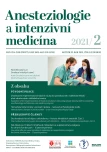Bartonella endocarditis as a cause of acute heart failure.
Importance of routine echocardiographic examination in acute respiratory failure in intensive care units
Authors:
J. Zatloukal 1,2; J. Široký 3; J. Lhotský 4; J. Beneš 1,2,5
Authors‘ workplace:
Klinika anesteziologie, resuscitace a intenzivní medicíny, Lékařská fakulta v Plzni, Univerzita Karlova
1; Klinika anesteziologie, resuscitace a intenzivní medicíny, Fakultní nemocnice Plzeň
2; Kardiochirurgické oddělení Fakultní nemocnice Plzeň
3; Kardiologická klinika, Lékařská fakulta v Plzni, Univerzita Karlova a Fakultní nemocnice Plzeň
4; Biomedicínské centrum, Lékařská fakulta v Plzni, Univerzita Karlova
5
Published in:
Anest. intenziv. Med., 32, 2021, č. 2, s. 106-108
Category:
Case Reports
Overview
The community of physicians was largely aware of Bartonella quintana especially at the beginning of the last century and in connec tion with occurence of so called trench fever. Today, it is a not very common cause of infectious endocarditis, especially in patients with immune compromise. The trickery of this bacterium is that in most cases it is not detectable in blood culture, or only after a very long cultivation. The definitive diagnosis can usually be made only on the basis of polymerase chain reaction (PCR) from the collected valve material. The case report presents the case onalosf a 69 year old woman admitted to intensive care, originally for bronchopneumonia, who was diagnosed with a severe valvular defect and endocarditis diagnosed with the aid of echocardiographic examination. Presented case report tries to highlight the importance of routine echocardiographic examination performed by an intensivist-non-cardiologist and also to draw attention to the not very common case of cultivation negative endocarditis.
Keywords:
bartonella quintana – bacterial endocarditis – echocardiography
Sources
1. Foucault C, Brouqui P, Raoult D. Bartonella quintana Characteristics and Clinical Management. Emerging Infectious Diseases 2006; 12(2): 217–223.
2. Mohammadian M, Butt S. Endocarditis caused by Bartonella Quintana, a rare case in the United States. IDCases 2019; 17, e00533. doi: 10.1016/j.idcr.2019.e00533
3. Okaro U, Addisu A, Casanas B, Anderson B. Bartonella species, an emergingcause of blood‑ culture‑negative endocarditis. Clin Microbiol Rev. 2017; 30(3): 709–746.
4. Edouard S, Nabet C, Lepidi H, Fournier PE, Raoult D. Bartonella, a Common Cause of Endocarditis: a Report on 106 Cases and Review. Journal of Clinical Microbiology 2015; 53(3): 824–829.
5. Vieillard‑Baron A, Millington SJ, Sanfilippo F, Chew M, Diaz‑Gomez J, McLean A, et al. A decade of progress in critical care echocardiography: a narrative review. Intensive Care Medicine 2019; 45(6): 770–788.
6. Zieleskiewicz L, Muller L, Lakhal K, Meresse Z, Arbelot C, Pierre‑Marie Bertrand PM, et al. Point‑of‑ care ultrasound in intensive care units: assessment of 1073 procedures in a multicentric, prospective, observational study. Intensive Care Medicine 2015; 41(9): 1638–1647.
7. Feng M, McSparron JI, Kien DT, Stone DJ, Roberts DH, Schwartzstein RM, et al. Transthoracic echocardiography and mortality in sepsis: analysis of the MIMIC‑ III database. Intensive Care Medicine 2018; 44(6): 884–892.
8. Linhartová K, Beneš J, Gregor P. 2015 ESC Guidelines for the management of infective endocarditis. Summary document prepared by the Czech Society of Cardiology. Cor et Vasa 2016; 58(1): e107–e128.
Labels
Anaesthesiology, Resuscitation and Inten Intensive Care MedicineArticle was published in
Anaesthesiology and Intensive Care Medicine

2021 Issue 2
Most read in this issue
- Timing of surgery following SARS‑CoV- 2 infection: an international prospective cohort study.
- Blocks of cutaneous nerves and fascias layout of the thigh
- Hemodynamic changes in prone position – a non‑invasive physiological study
- Neinvazivní a invazivní monitorace hemodynamiky na jednotce intenzivní péče
